Baleen Whales

Heads of two feeding humpbacks
Mysticetes, or baleen whales, share at least one thing in common: instead of functional teeth, all have baleen (sometimes referred to as “whalebone”) inside the mouth. Each plate of baleen consists of long flexible hairs bound together by connective tissue and embedded in the upper gum. Made of keratin, they are similar in appearance to human fingernails. Hundreds of plates, one alongside the other, line each side of the upper jaw, hanging downward. Where the whales tongue rubs against the baleen, the baleen is worked into a series of bristles. This inner fringe allows whales to filter large quantities of small prey from the water. Different species of baleen whales differ in the shape of the baleen and the fineness of the fringe. This reflects different feeding styles and food types: short baleen plates with a coarse fringe describes a fish-eating whale; long plates with a fine, silky fringe allow others to hunt smaller animals such as zooplankton.
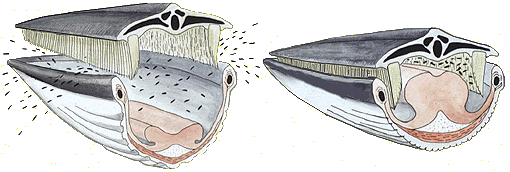
The images above show a cross section through the head of a generalized baleen whale where the baleen appears yellow, pink areas are the tongue and associated muscles, black dots represent food items. Water and food pours into the mouth as the mouth is opened (left); the mouth is shut part way, the tongue is expanded to push out the water, while food items, unable to escape through the baleen, are trapped (right).
At least three broad feeding styles can be found within the baleen whales: gulp feeders, skim feeders and bottom feeders. Gulp feeders, like humpback, fin and minke whales, engulf a large mouthful of food and water, close the mouth part way and, with the tongue, force the water back out through the baleen. The food cannot pass through the baleen and is swallowed whole. Long, parallel grooves, or pleats, run the length of the throat, allowing the throat to distend – almost like the pouch of a pelican (baleen whales with these “rorqual grooves” are classified together as rorqual whales, such as fin and humpback whales). This feeding style works well with schools of small fish or large plankton.
Skim feeders, like right and sei whales, pass through patches of plankton-rich water with their mouths open. As food and water flow into the mouth, the water passes out through the baleen. Food items, trapped against the fringe of the baleen can be directed to the throat by the tongue.
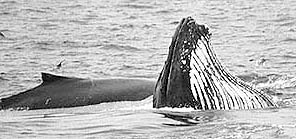
Mother/calf humpbacks: female has just gulped
fish and water; extended throat and rorqual grooves
Gray whales, the only known bottom feeding baleen whales, plow rich sea bottoms, filtering invertebrates from mud and water.
Besides the unique filtering system for feeding, most baleen whales share a number of broad characteristics in common. Most have wide ranges and extensive migrations. They lack any known capability for sonar or echolocation. They often have a mating system in which both males and females are promiscuous. Often, they exhibit a relatively short period of maternal care with no strong kinship bonds aside from a mother and her new calf. They have large bodies requiring massive quantities of small prey.
Despite these commonalties, the baleen whales of Stellwagen Bank show many differences.

Large head and areas of rough skin (callosities) distinguish a right whale
North Atlantic right whales, Eubalaena glacialis, are considered one of the rarest of the baleen whale species. Distinct populations of right whales were scattered across the oceans of the world until they were decimated by heavy and consistent whaling.
These are large whales, up to 17m. (56 feet) and may weigh up to 100 metric tons. Much of their body length is taken up by their massive head and long, curved mouth line that supports a massive rack of baleen. Each baleen plate is up to 3m (8 feet) long and very narrow. The fringe along the inside edge of the baleen is very fine, allowing right whales to filter very small but plentiful food items, especially copepods.
Large broad flukes help push the rotund body through dense patches of zooplankton, even with the extra drag the open mouth. Paddle-like flippers increase maneuverability for feeding and social behaviors. Not built for speed, right whales have no dorsal fin on the back. Over most of the body, the skin is smooth and black. Rough, light-colored areas can be found on the top of the head, around the blowholes, chin, jawline and above the eyes. Collectively known as callosities, these patches create the perfect home for cyamids or whale lice. Dense colonies of these invertebrates color these patches tan or white. Because the callosities do not change over the lifetime of the individual, the pattern can be used to identify individuals.
Seasonal movements are still poorly understood but, generally, they move between rich summer feeding grounds and warm winter calving grounds. During summer and fall most of the population feeds on different banks in Southeast Canada such as the Bay of Fundy. “Courtship groups” are also seen at this time. During November and December right whales almost disappear with a few scattered reports coming from far flung areas such as Jeffreys Ledge off Northern Massachusetts and offshore of Cape May, New Jersey. By late winter and early spring, two distinct aggregations appear: calving females off southern Georgia/northern Florida and non-calving animals feeding (Mayo, 1998) off the Massachusetts coast (Cape Cod Bay, Great South Channel and Nantucket Sound).
Until about half a century ago, the North Atlantic population was believed to be extinct. Since the discovery of a relic population, research and conservation efforts have worked to learn more about right whales and their habitat requirements with an eye to recovery. Although protected from hunting, the right whale population still carries heavy losses from entanglements and ship strikes. How the population might be affected by habitat degradation is still being studied through long term research efforts here, at CCS, by collaborating research labs and government agencies along the eastern seaboard.
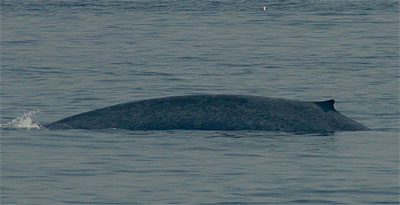
A blue whale arches before a dive on Stellwagen Bank; Summer 2002
Blue whales, Balaenoptera musculus, are rarely seen on Stellwagen Bank. As the largest animal on earth (up to 33m or a hundred feet), much of the Bank is simply too shallow for them – they would hit their chin during a dive! A more realistic average size might be something like 80 – 85 feet; yet, even with this extra clearance, most blue whales would find Stellwagen uninhabitable for any length of time. Quite simply, there is little here for a blue whale to eat. Krill, the favored food of blue whales, cannot be found on the Bank in quantities suitable for a population of 80 or 90 ton animals.
Despite the fact that Stellwagen is not ideal blue whale habitat, they have been spotted a few times. Small, periodic explosions of krill on Stellwagen may support a stray blue as it moves on to richer feeding grounds further offshore or to the North, such as the Gulf of St. Lawrence, in Canada. Add to this their extreme rarity due to historic over hunting, the sight of a blue whale here is exceptionally rare.
Their large size, relatively tiny dorsal fin and mottled gray-blue skin make them relatively easy to identify from the more common, local whales such as the closely related fin whales.
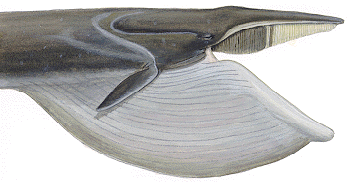
Open mouth and baleen of the right side of a fin whale
Fin whales, Balaenoptera physalus, are second only to the blue in size. At over 60 feet (18 m) and over fifty tons, large fin whales are a spectacular sight on Stellwagen. Built for speed, their body is long and sleek. The tail stock is flattened vertically to a thin keel to reduce drag as the wide flukes are pumped up and down for swimming. A tall dorsal fin probably helps to keep the whale from rolling during high speed swimming, with sprints up to 12 (20 km) an hour.
The overall color tends to be dark brown or warm gray above and cream or white beneath. Fin whales are unusual in that the coloration of the head tends to be asymmetrical: the right hand side of the lower lip, and much of the baleen, is usually stark white as opposed to gray or brown on the left side. This “blaze” and other light patches, or chevrons, about the head and back (along with the shape of the dorsal fin) can be used to identify individual fin whales over time.
Relatively little is known about the movements and behavior of fin whales: they travel quickly and individuals are difficult to identify in the field, making research a real challenge. Photo-identification of fin whales (Agler, 1993) has begun to clarify their natural history. In some years, Stellwagen provides good feeding for large numbers of fin whales in spring, summer and fall. This includes females and their young calves. Many of these whales visit Stellwagen year after year. Just where most fin whales spend the winter, and where (or if) breeding grounds may be, is still a mystery.
Feeding on small schooling fish like sand lance, herring or mackerel, fin whales rely on speed. After locating a patch of bait, fin whales may spend some time circling the school, possibly concentrating the fish. During the final sprint, they may roll on their side, mouth agape, engulfing as many fish as possible. Massive amounts of oily fish will translate into layers of fat to be used as food storage for the lean times of winter and as milk for growing calves.
Fin whales are a cosmopolitan species, found usually in subpolar and temperate seas across the globe. Protected by their speed during the early stages of whaling, abundant fin whale stocks were decimated by the technology of modern whaling: exploding harpoons and engine driven catcher boats. Today they are listed as Endangered by the U.S. Endangered Species Act and are afforded protection by the Marine Mammal Protection Act.
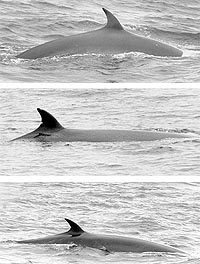
Three photo identification shots of sei whales from Stellwagen;
are they different individuals?
Sei whales, Balaenoptera borealis, are another little-known whale species that is found only sporadically on the Bank. Their long, streamlined shape is reminiscent of the closely related fin and minke whales; a body design built for efficient speed. At sea they are easily confused with the larger fin whales but, they tend to be a dark, cool gray, the dorsal fin tends to be smaller and more falcate (sickle-shaped), and they are symmetrically colored about the head. They also tend to be smaller than fin whales, rarely pushing 15 m (50 feet).
By all accounts, inshore sightings of sei whales tend to be sporadic and, likely, are related to abundance of their prey. Records from northern whaling stations reported that most sei whales had copepods in their stomachs as well as krill and small, schooling fish. This varied diet is reflected in their feeding styles: they can be found travelling slowly, just below the surface, mouth open, skimming for zooplankton (likely copepods) or, lunging through patches of fish or krill with the rorqual pleats extended, as they gulp feed.
Sei whales may be a good indicator of cyclical changes on Stellwagen Bank. For example, during the summer of 1986 (Schilling, 1992), whale-watchers were surprised by the fact that very few humpback whales were present on the Bank. The population of sand lance, the small fish that makes up a bulk of the humpback’s diet here, seemed to be exceptionally low. Copepods, the main source of food for sand lance, exploded in their absence, creating a temporary hot spot for feeding sei and right whales Perhaps coincidentally, one of the few sightings of a blue whale, another planktivorous species, came from this year as well.
Like fin whales, sei whales were not heavily hunted until the advent of modern whaling. As high speed vessels evolved, the sei whale population crashed. They are listed as Endangered on the U.S. Endangered Species List and are poorly understood.

Note the white flipper patch; variable areas of light patches on sides
Minke whales, Balaenoptera acutorostrata, are the smallest baleen whale species on Stellwagen Bank. At about 8 m (25 feet long), they have a sleek body design built for speed. Like many marine animals they are counter shaded: dark on top (dorsally) for camouflage when viewed from above, and light below (ventrally) to blend in with the light at the surface when viewed from below. The dorsal surface tends to be a dark, cool gray, sometimes with swaths of pale gray or white on the flanks and back, while the ventral surface is stark white with areas of pink. In the North Atlantic, most minkes have a bright white band on each, short flipper. Their head is long and pointed; the dorsal fin is tall and sickle-shaped.
Minke whales are relatively small, they usually travel alone or in very loose groups, they don’t generally create a spout when at the surface and often change direction quickly. All of these characteristics make them a challenging whale to observe. Consequently, relatively little is known about minke whales: calving rates, where the different sub-populations go for different seasons, their habitat requirements, etc. One of the few systematic studies of minke whales in this area, was carried out by Margaret Murphy, here at CCS (see 1995 Murphy). The number of minkes that use Stellwagen Bank changes from year to year and calves are rarely observed here. May through September seems to be a peak time for minkes in this area. Like the sei whales mentioned above, identifying individuals can be a big challenge due to their speed and the subtle differences between individuals.
On the Bank, minke whales can be found in areas where other whales, like fin and humpback, are feeding. Studies of minkes in other areas indicate that their diet may be more diverse than other local baleen whales, taking advantage of whatever is abundant in a given area or given time: copepods, krill, capelin, herring, sand lance and squid. Interestingly, the smaller minke may feed on larger food items than the larger whales do, taking fish as large as cod and pollock. Minke whales may be very flexible in their feeding strategies: chasing down small groups of large, fast swimming fish or lunging through dense patches of bait fish or zooplankton. Despite these observations, just how minke whales use Stellwagen Bank is still poorly understood. Minkes are rarely observed feeding at the surface on the Bank.
Minke whales are a cosmopolitan species with populations scattered throughout the oceans of the world. In the North Atlantic, at least three different stocks are recognized. Minke whales on Stellwagen Bank are part of the Canadian East Coast stock including all of the Gulf of Maine. These populations seem to be separate and genetic variability between populations may represent different species. Certainly, they are the most numerous baleen whale species at present. Their small size and unobtrusive behavior made them unattractive to many whaling operations until other larger whale species became commercially extinct or rare. Today minkes are still hunted by a few nations including Norway and Japan.

Long white flippers and irregular dorsal fin are characteristic of North Atlantic humpbacks
Humpback whales, Megaptera novaeangliae, may be the most unique of the rorqual whales (baleen whales with parallel throat grooves). The species gets its common name from the prominent hump in front of the dorsal fin (see image below). However, its scientific name essentially means “big winged New Englander” and refers to their exceptionally long pectoral flippers. Humpback whale flippers can be as long as one-third of their total body length. In the North Atlantic, the majority of humpbacks have flippers that are predominantly white on both sides (although they appear greenish when viewed through plankton-rich, high-latitude waters). By contrast, the flippers of North Pacific humpback whales tend to be black on the top. These long appendages are what allow humpback whales a surprising array of complex movements and behaviors. At the same time, long flippers may increase the surface area so that body heat can be lost to the surrounding water, a helpful asset to a well insulated mammal on its warm water breeding grounds.
Another noteworthy characteristic of humpback whales is that they generally raise their tail (flukes) above the surface of the water as they go on a dive. Across the underside of those flukes there is a variable pigmentation pattern of black and white. The whales are born with this pattern and it stays pretty much the same throughout their life (although scarring from competition, play or encounters with predators certainly leave their marks). This unique pattern, as well as the shape of the dorsal fin, can be used to identify individual humpback whales in a population.
Much of what is known of humpbacks today comes from the fact that, as whales go, individuals are relatively easy to identify. Once an individual is photographed for the first time, it can be catalogued and even named. Through a technique called photo-identification, re-sightings of the same individual at different times and places help scientists to piece together its life history. From many individuals it becomes possible to draw conclusions about humpback whale populations and the species as a whole. Humpbacks are often considered the best studied of the baleen whales. Despite this, humpbacks are far from well-understood.
The Gulf of Maine, off New England, is one of several humpback whale feeding areas scattered across the North Atlantic Ocean. Other important feeding areas can be found off Canada (Gulf of St. Lawrence, Newfoundland and Labrador), west Greenland, Iceland and Norway. In spring, summer and autumn, humpback whales feed on a wide range of schooling fish species and euphausiids, depending upon what is locally available at a given time. Stellwagen Bank is one of the best-known feeding areas in the southwest Gulf of Maine. However, humpback whales actually forage over a wide range of near-shore and offshore areas in this region. The prevalence of humpbacks at any particular mid- to high-latitude area is a reflection of the abundance of their preferred prey. For example, sand lance is one favorite food of humpback whales in the southern Gulf of Maine. When sand lance abundance is low on Stellwagen Bank, humpbacks bypass that area for more productive areas further north, south or offshore.
Humpback whales are known for their long migrations from polar and temperate feeding grounds to tropical breeding grounds. Around the world, humpback whale breeding grounds are generally found in waters less than 200 meters (600 feet) deep and latitudes of less than 25 degrees. However, recent research suggests that a narrow, warm water temperature range (21-28 degrees C) may be the most universal characteristic of these areas. Humpback whale breeding areas rarely offer whales much in the way of food. The primary preoccupation of most humpbacks in the winter time is reproduction. The stores of fat, packed on during the feeding season are used by late pregnant females give birth, nurse and bond with their calves. Adult males compete physically with each other in what is known as “competitive” or “rowdy” groups. The victors of these battles are thought to mate with mature females, but this has yet to be observed. Males are also the only humpback whales that produce long, stereotypical vocalizations known as song. The role of whale song in the mating system is still poorly understood. How this behavior is learned and what kind of information it communicates is still unknown.
Humpback whales on the US East Coast were once listed on the Endangered Species List in the United States, and are still protected by the Marine Mammal Protection Act. Since the moratorium on commercial whaling, many humpback whale populations across the world have shown evidence of increase. This species is no longer considered at risk of extinction on a world scale. However, humpbacks and other whale species are still impacted by other human activities, such as fishing and ship traffic. The specific status of humpback whale recovery in the North Atlantic Ocean and elsewhere is still being evaluated.
Long term studies of humpbacks in the North Atlantic have been a cornerstone of our research at the Center for more than three decades. Find out more here.

Our Work
Humpback Whale Research
Right Whale Research
Marine Animal Entanglement Response
Marine Geology Department
Water Quality Monitoring Program
Marine Fisheries Research
Seal Research
Shark Research
Marine Education
Interdisciplinary
Marine Debris and Plastics Program
Marine Policy Initiative
Cape Cod Climate Change Collaborative
Publications

